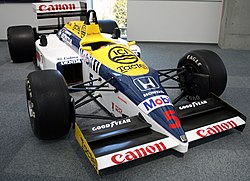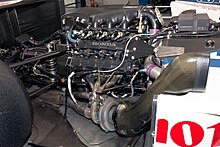Williams FW11
|
Williams FW11 Honda |
|||||||||
| Constructor: |
|
||||||||
| Designer: | Patrick Head , Frank Dernie | ||||||||
| Predecessor: | Williams FW10 | ||||||||
| Successor: | Williams FW12 | ||||||||
| Technical specifications | |||||||||
|---|---|---|---|---|---|---|---|---|---|
| Chassis: | Monocoque made of carbon fiber reinforced plastic | ||||||||
| Wheelbase: | 2794 mm (1986) | ||||||||
| Weight: | 540 kg | ||||||||
| Tires: | Goodyear | ||||||||
| Petrol: | Mobile | ||||||||
| statistics | |||||||||
| Driver: |
|
||||||||
| First start: | 1986 Brazilian Grand Prix | ||||||||
| Last start: | 1987 Australian Grand Prix | ||||||||
|
|||||||||
| World Cup points: | 141/137 | ||||||||
| Podiums: | 19/18 | ||||||||
| Leadership laps: | - | ||||||||
The FW11 is a racing car that the Williams F1 team used in the 1986 Formula 1 season . A slightly modified version, the FW11B , followed in the 1987 season . In 1986, the FW11 was the dominant car in the field and scored nine wins. Williams-Honda won the constructors' championship with it; However, McLaren driver Alain Prost defended the driver's title . In 1987 the FW11B again won nine victories, Williams-Honda won the constructors' title again and Nelson Piquet achieved his last of a total of three world championship titles.
background
Team Williams entered into a partnership with Japanese manufacturer Honda at the end of the 1983 season . After initial difficulties, the first successes came and towards the end of the 1985 season , the turbo-charged Honda engine developed into the leading drive in the field. The two Williams drivers Keke Rosberg and Nigel Mansell won five races. Rosberg left the team at the end of the season and went to McLaren, for which, at the instigation of Honda, the two-time world champion Nelson Piquet was signed as the new number 1 driver for the new season. Mansell remained in the team as the second driver.
Design and construction of the FW11
The FW11 was designed by Patrick Head and Frank Dernie . It had a Honda V6 1.5 liter turbo engine, a manual six-speed transmission from Hewland and carbon brake discs. In order to meet the changed regulations, which stipulated a reduced maximum fuel quantity of 195 liters (instead of the previous 200 liters), Williams designed a narrower gasoline chamber together with gasoline supplier Mobil. This made possible (in direct comparison to the FW10 predecessor model) a significantly lower car with a more favorable aerodynamic center of gravity. According to aerodynamicist Frank Dernie, making the body as narrow and low as possible was an essential requirement when designing the FW11, because the Honda engine was larger than the engines from its direct competitors Renault and TAG-Porsche. Honda also contributed a new engine management system that enabled direct telemetry transmission from the car to the pits. The Honda engine developed 900 bhp under racing conditions; it could be driven with four different boost pressure settings. Another innovation was the built-in radio, which enabled an exchange between the driver and the pit control center during the race.
1986 season
Before the start of the season, team owner Frank Williams sustained life-threatening injuries in a car accident. Patrick Head took over the team management in his representation. In the course of the season the team won nine races, Mansell five, Piquet four. Internally, a tough rivalry developed between drivers Nelson Piquet and Nigel Mansell; As the number 1 driver, Piquet was dissatisfied that the team did not grant him preferred status. Before the season finale in Adelaide, Australia, both, like Alain Prost, had the opportunity to become world champions in McLaren-TAG ; World Championship leader Mansell lost all title chances due to a burst rear tire. After the forced pit stop, Piquet was only second behind the winner Prost, who won his second title.
FW11B
A new design was originally planned for the 1987 season. However, Williams used a slightly modified B version of the FW11 after Honda did not deliver the lower engine with a lower center of gravity expected for 1987. Among other things, the oil filter should be on the side instead of under the crankshaft. The vehicle to go with this engine was almost finished when it became clear that it would stay with the old, higher type. So the revised construction from the previous year had to be used again. The B version of the FW11 finally presented had a newly designed interior cockpit with an even lower seating position for the driver, which improved the airflow to the rear wing. As a result, the downforce of the FW11B was significantly stronger compared to the previous model, without generating more air resistance. In the course of the season, Honda delivered a further expansion stage of its engine with the RA168G, which was initially able to achieve 13,000 revolutions per minute and 950 bhp. According to project manager Osamu Goto, four different expansion stages of the RA168G were used during the season. These engines were even cheaper in terms of fuel consumption than the previous models.
1987 season
With the slightly modified B version of the FW11, Williams also dominated the 1987 season. Mansell won six races. Piquet, who had a serious training accident in the Tamburello curve at the Imola race weekend and then suffered from impairments throughout the season, won three races. Nevertheless, Piquet's performance as a driver was less fluctuating over the course of the season, while Mansell was set back by (self-caused) accidents and technical damage. Towards the end of the season, Piquet used the active suspension on his car and won the Italian Grand Prix ; Mansell, on the other hand, was skeptical after bad experiences with the new technology and drove with conventional suspension. Piquet won the driver's title without a fight at the penultimate round in Japan after Mansell was unable to start due to an injury in free practice after an accident. He was replaced by Riccardo Patrese in the last race . In addition, the team comfortably defended the constructors' championship. However, Honda ended the partnership at the end of the year and decided to supply McLaren and Lotus in 1988 . Team boss Frank Williams attributed this decision, among other things, to Honda's mistrust in his ability to continue to lead the team effectively after his accident-related paraplegia.
literature
- Alan Henry: The Turbo Years. Crowood Press, Swindon, 1990. ISBN 1-85223-397-4 .
- Peter Higham: Formula 1: Car by Car 1980-89. RACE POINT PUB, London 2018, ISBN 978-1-91050-523-6 .
Web links
Individual evidence
- ^ Alan Henry: The Turbo Years. Crowood Press, Swindon, 1990. pp. 211 f.
- ^ Alan Henry: The Turbo Years. Crowood Press, Swindon, 1990. p. 213.
- ↑ Lunch with ... Patrick Head. motorsportmagazine, March 1, 2012, accessed on March 25, 2019 .
- ^ Alan Henry: The Turbo Years. Crowood Press, Swindon, 1990. p. 235.
- ↑ Love him, hate him ... He didn't give a damn. motorsportmagazine, December 1, 2013, accessed on March 25, 2019 .
- ↑ Maurice Hamilton: Frank Williams. The inside story of the man behind the cars. Macmillan, London 1998, p. 174.
Remarks
- ↑ Patrick Head quoted from F150: Formula 1: 50 golden years Volume II. Harrow 1999, p. 102 f .: “The Honda engine had a higher crankshaft because there was an oil filter underneath, and I made life difficult for them, because they put their entire engine on that filter. Why didn't they put the filter on the side and lowered the whole engine? At the end of 1986 I went to Japan for a joint meeting with Honda and Gérard Ducarouge because Lotus wanted to use the Honda engine in 1987. The Honda man showed me a welded crankcase with a subplate and the filter on the side. The thing ran over the dynamometer [meaning an engine test bench ]. He had tried to make the engine lower with this super-low crankshaft. I knew he was working on it, and since we assumed that would be the basis for a new engine, we had designed a new, much smaller and more compact car for 1987. I was really upset when Ducarouge said, 'No, no, no, we don't need that.' So Honda stayed with the old engine and we could only scrap the planned FW12 for 1987. We were very advanced with the design and it was November when Honda scrapped the low-profile engine - which they then showed off with the McLaren in 1988 when they turned their backs on us. "


